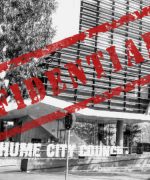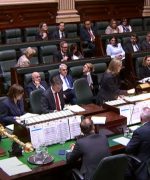Among the topics put to Hume Council by rate payers via written questions at its Monday 13 November meeting (link to minutes) included asking about the city’s purchase of EV cars, rubbish bins, and whether security cameras can be installed around a popular lake.
Caroline Aspinal asked if more rubbish bins around the Highlands Craigieburn lake would help as “…people probably dump their rubbish due to the lake being full of trash anyway”.
Adam McSwain, the council’s director infrastructure and assets says littering is “…not necessarily linked to the presence of bins or other infrastructure”.
“There are approximately seven bins located around the lake and these bins are emptied three times per week. Officers will arrange a litter audit of this site to ascertain if the current service levels and infrastructure is sufficient,” he said.

“Community members can assist us in our work, by reporting litter and illegal dumping, through a mobile app called Snap Send Solve. The app makes reporting local issues easier and will enable our teams to respond accordingly.”
Aspinal also asked if CCTV cameras can be installed around the Highlands Craigieburn lake to help prevent “…graffiti, drug use, dirt bikes being driven at all times of the day and night, animal cruelty – dead birds etc?”
McSwain said it would be too expensive and that “…issues pertaining to drug use, illegal dirt bike riding and animal cruelty fall beyond the jurisdiction of council enforcement powers”.
“Concerns regarding graffiti should continue to be reported to council,” he said.
Illegal rubbish
Bianca Tilli has submitted more than 15 requests for the removal of illegally dumped rubbish around Broadmeadows in the past year.
“I noted the waste and resource recovery strategy’s proposal via Hume city council annual report that speaks to introducing a three-bin system,” she said.
“While this is commendable, could you please explain how the implementation of the three-bin system is expected to reduce the occurrence of larger items being illegally dumped on nature strips?”
McSwain said: “It is unlikely to significantly impact the occurrence of illegally dumped waste.
“Council has appointed two new resource recovery education officers, who will provide education to the community on a variety of topics, including correct bin use and responsible waste disposal, such as utilising council’s existing hard waste and tip voucher services.”
Council EVs
Greg Perkins wrote to council saying the Ford motor company is selling electric vehicles at a US$30,000 loss and has shelved a US$12 billion investment in EVs.
“This is due to the continual poor resale values of vehicles, expensive battery replacements, sudden ignition of batteries and dropping sales worldwide,” he said.
“Should the Northern Council’s Alliance’s Community Electric Vehicle Transition Plan: Part A be seriously looked at due to falling demand for electric vehicles and drastically downgraded or defunded in the interest of ratepayers?”
The council’s Adam McSwaine said: “Councils adopted Climate Action Plan 2023-2028 includes an action to transition to electric vehicles for fleet and passenger vehicles and light commercial vehicles at the end of their replacement cycle.
“This action is to be funded from within the program budget. As such, [council] officers will continue to monitor the price and cost benefit of transitioning to electric vehicles and bring further reports to Council as required to ensure suitable community benefit is maintained.”
Fire risk
Perkins also said electric vehicles, or any rechargeable battery products, “…have a fire risk and are a large contributor to falling [EV] sales”.
“While fires caused by batteries are not common, they can cause immeasurable damage,” said Perkins. “Fires can burn for up to three days and dangerous chemicals are emitted into the atmosphere.
“Northern Council Alliance’s “Community Electric Vehicle Transition Plan: Part A” does not mention this as a risk (as far as I can ascertain) and I would have thought it should be listed under Section 9.6.4, Risks Liabilities, Vandalism and Enforcement.
“What is the council’s and/or Alliance’s risk assessment and hazard policy should an EV catch fire at a proposed council facility?”
McSwain said the council will continue to complete risk assessments, review relevant safety guidelines and ensure that any identified hazards are suitably mitigated.
“If an incident were to occur this would be reviewed and changes made as appropriate,” he said.
The Voice referendum
Keryn Wells asked how much the council spent on The Voice referendum.
Andrea Andrews, the council’s acting director customer and strategy said: “Council maintained a neutral stance and did not allocate funds towards advocating any position in the recent referendum. Our involvement was strictly informational and facilitative.
“This included distributing non-partisan information about the referendum in libraries and on social media, and leasing the G floor of the Hume Global Learning Centre Broadmeadows to the Australian Electoral Commission for use as an early voting point.
“Our commitment was to inform and support the community’s participation in the democratic process, without influencing their choices.”
Public nuisance

Kevin Ballam asked: “When deciding on approving applications for planning, building, events, etc, what emphasis does council place on minimising disruption to users of adjoining public land, facilities and infrastructure?”
The council’s Rachel Dapiran, director city planning and places, said: “The impact of a proposal on current and future residents and adjoining public land and infrastructure is “…always a relevant consideration”.
“Conditions will often be added to any planning permits issued to mitigate impact on surrounding properties, public land or infrastructure.”
Public spaces
Ballam also asked about the action council takes when construction and building activities take up public space (eg paths) “…creating a hindrance to people who would be users of that space?”
Dapiran said: “Work in the road reserve is managed in accordance with the Road Management Act 2004, and under this there is also a Code of Practice for Worksite Safety – Traffic Management.
“Where the construction activity is road-related, traffic management plans are required to consider access and safety for all road users. This aims to deter unnecessary occupation of the road reserve while ensuring safety for road users.”
Reader note: Links in the above report were put in by SunburyLife for reference.









